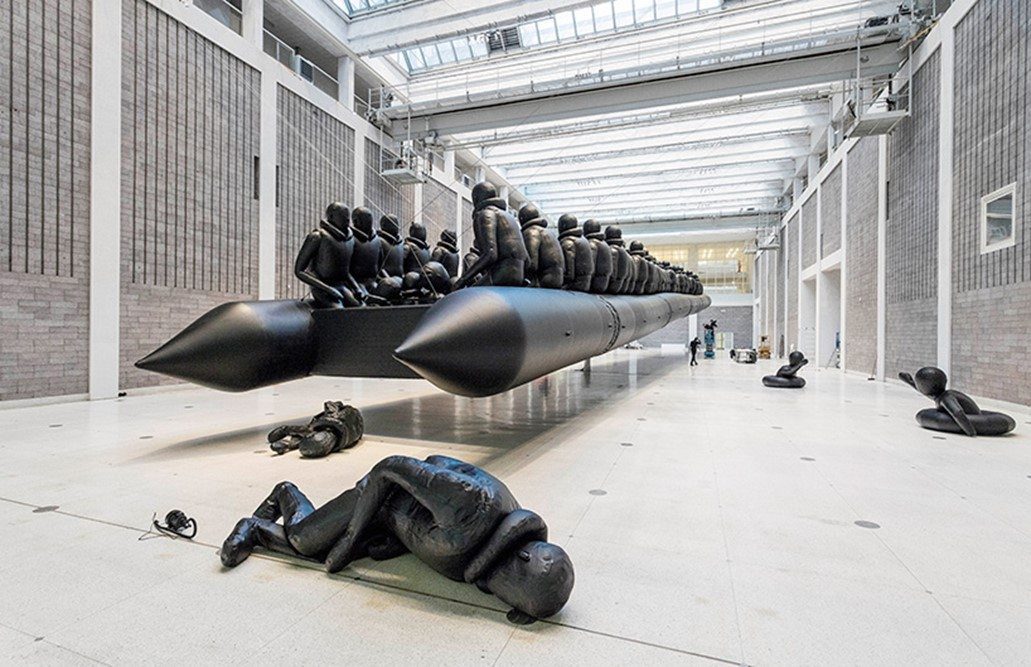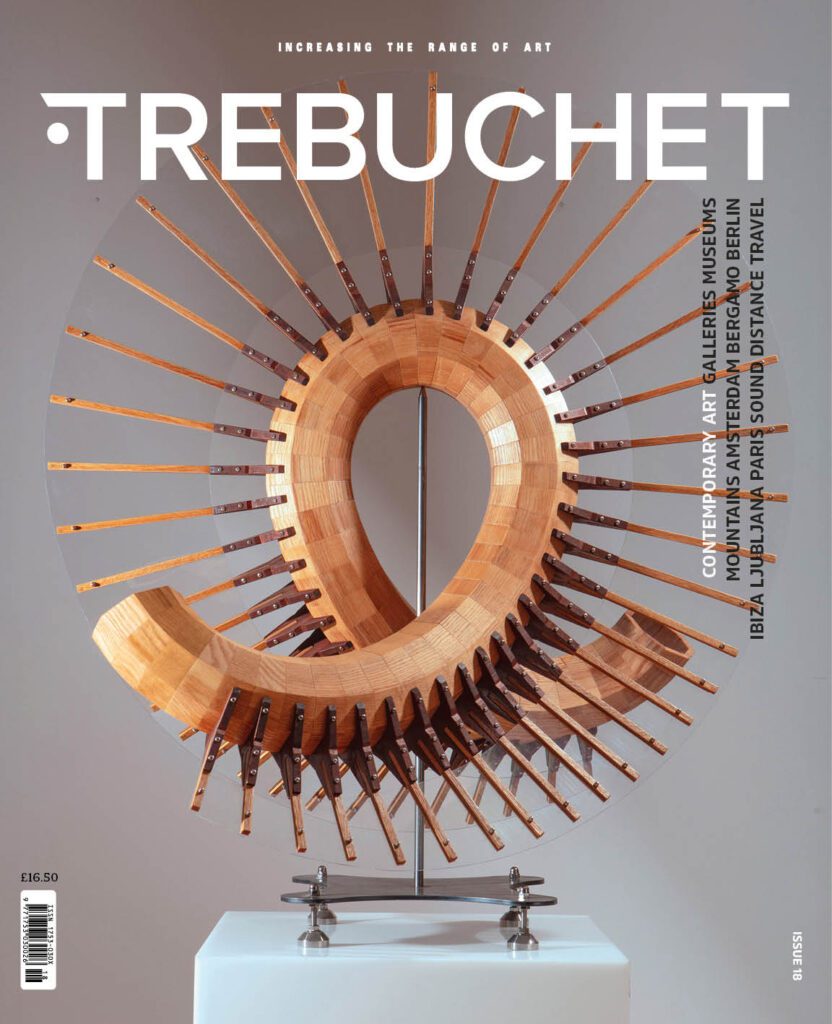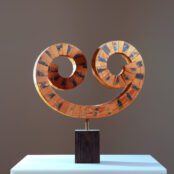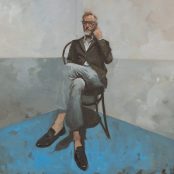[dropcap style=”font-size:100px;color:#992211;”]C[/dropcap] hina is growing its ‘soft power’ portfolio and art is a sound investment. In 2017 the painting above sold for $49 million at Christie’s in New York. Natalie Andrews explores Chinese tastes and where the money is going in this two part investigation for Trebuchet.
As of 2013 according to the European Fine Art Foundation and reported in the Guardian by Matthew Caines, the USA was identified as the biggest contributor to global art market. This confirmed what most people took for granted. It also confirmed another art world truism, that China is both in second place and growing year on year. The duel between the two super powers for economic and cultural dominance extends into the world of art, a soft power area, partly because art is a sound investment.
Money, money, money
“Sales in the US increased by 25% year-on-year, confirming its position as the key centre for sales of the highest priced art…China remains the most important of all of the newer art markets, both in terms of the size of its domestic sales and the importance of its buyers globally,” Matthew Caines, 2013 International art market 2013: new report examines the facts and figures
Over time China is growing its share and reports more recently are about the amount of money exchanged by Chinese buyers in domestic auction houses. The popularity of Zhang Daqian plays into the trend for China to buy art that reflects a quintessential Chinese character,
“There is general agreement that China was the biggest-grossing region for auction sales in 2016…The February overview from Artprice and Art Market Monitor of Artron ranked the Chinese artist Zhang Daqian (1899-1983) as the world’s biggest-seller at auction in 2016, with sales totalling $354.8 million. ‘The wealth dynamics will play out,’ said Ms. McAndrew, whose report noted that the most rapid growth in wealth was in Asia, where a billionaire is created every three days, according to UBS” Scott Reyburn, ‘What’s the Global Art Market Really Worth? Depends Who You Ask’ 2017, NewYork Times.
Zhang Daqian, artist of choice for the discerning lucky few
Daqian’s work, the epitome of what the Chinese aspire to buy is accomplished and also shows a strong understanding of how to combine abstract and representative features. His output though is traditional (he was also known as ‘the traditionalist’) While there is nothing wrong with this, it does mean that the ideas are stabilising, meditative and overall not addressing contemporary power. Power has been the subject of modern Chinese artists, their work tends to find foreign buyers.

LUSH MOUNTAINS IN MISTY GLEAM Zhang Daqian (Chang Dai-chien, 1899-1983)
Various commentators recognise that China has identified the ‘soft power’1 potential of fine and traditional arts. This includes promoting China as the go to place when money is to be made from art sales and to generally have China thought of as being associated with the arts and prosperity,
“China has identified culture as a core area for economic growth, and a vibrant art market as a useful tool of soft power, promoting a view of Chinese society as a center of aesthetics and beauty and deflecting the international focus from political and human rights issues,” David Barboza, Graham Bowley and Amanda Cox ‘A Culture of Bidding, Forging an Art Market in China’ New York Times 2013
Soft Power
Joseph Nye coined the term ‘soft power’2 in his piece for Washington post Newsweek Interactive. In this essay he is critical of China’s use of soft power. Nye sees China as depending on its might rather than drawing on cultural nuances or diplomatic subtleties. Nye defines soft power as a kind of non-coercive form of persuasion or propaganda which seeks to co-opt opponents,
“A country may obtain the outcomes it wants in world politics because other countries – admiring its values, emulating its example, aspiring to its level of prosperity and openness – want to follow it. In this sense, it is also important to set the agenda and attract others in world politics, and not only to force them to change by threatening military force or economic sanctions. This soft power – getting others to want the outcomes that you want – co-opts people rather than coerces them,” Nye, Joseph. Soft Power: The Means to Success in World Politics, 2004, New York: Public Affairs
China has already
surpassed the United States
as Africa’s largest trading partner
This kind of propaganda is important for aspiring states to truly cement their power, rather than firefighting in every corner of their territory and being embattled by foreign states or global institutions. The veil of soft power and the castrating force of co-opting resistance serves to bamboozle some and give others the excuse they need to simply ignore any problems and cooperate, reaping the benefits. A type of plausible deniability.
For Trefor Moss though writing in ‘The Diplomat’ more recently, China is wielding soft power and while he considers Nye’s definitions useful Moss is clear that China is consciously perusing a strategy of soft power,
“No-one has been more skeptical about Chinese soft power than Joseph Nye, the man who first coined the phrase twenty years ago. In particular, Nye has criticized Beijing’s efforts to acquire soft power through centralized schemes, like the spread of Confucius Institutes or the establishment at the end of last year of the China Public Diplomacy Association. Despite “spending billions of dollars to increase its soft power … China has had a limited return on its investment,” he recently argued. This is because soft power mainly accrues when civil society actors – whom the Chinese government tends to squash – make or do things with global appeal, according to Nye, not through top-down schemes which foreigners are likely to interpret as propaganda,” Trefor Moss, ‘Soft Power? China Has Plenty’ 2014, The Diplomat
Context is Everything!
Moss goes on to argue that China’s soft power is far more effective depending on where you are in the world, he states that in Africa and in South America the policy works far better were resources are traded for education and infrastructure.3 For Yaghmaian Africa is also an important point of focus for China where Chinese investment has surpassed American interests,
“China has already surpassed the United States as Africa’s largest trading partner. Since 2005, China has spent more than $56 billion in sub-Saharan Africa, with significant investment in oil, platinum, copper, nickel and manganese and other extractive industries. China’s bilateral trade with African countries rose from $10 billion in 2000 to $125 billion in 2010. It will reach $300 billion by 2015,” Behzad Yaghmaian ibid
As Moss highlights though, the Chinese are not simply raiding Africa but showing genuine interest in both developing the continents infrastructure and encouraging immigration to China. Language classes and culture workshops are offered in the aptly named Confucius institutes,
“The Confucius Institutes teach Chinese language, martial arts, cooking and other China-related subjects…Nordtveit explained: “The Africans are impressed by China’s economic rise. That’s why they want to go to Confucius Institutes. Higher education and Confucius Institutes are helping economic development between China and Africa,” Trefor Moss, ibid.
This is battle China can win, since in Africa and other parts of the post-colonial world there is plenty of suspicion and resentment to old colonial powers as well as America’s old schtick which promised so much but delivered so little. African leaders are keen to deal with China and according to the sources I have looked at many Africans are keen to embrace China. 4
Ai Weiwei
There is further evidence to support Moss in his assertion that China is concerned with soft power and that this is backed by government policy,
“In 2011, as Xi Jinping was preparing to take power from General Secretary Hu Jintao, the 17th Central Committee of the Chinese Communist Party devoted a whole plenary session to the issue of culture, with the final Communiqué declaring that it was a national goal to “build our country into a socialist cultural superpower,” ‘The red carpet, China’s film industry,’ December 21st, 2013, The Economist
Further we can also look at the relationship of Ai Wei Wei as an example of both China’s obsession with ‘soft power’ and the tendency described by Nye for China to ‘squash’ civil society actors. Weiwei is himself just such an actor. Weiwei has been outspoken in his criticism of the regime despite efforts to assimilate him to the cause (he was commissioned to design the ‘Birds Nest’ stadium for China’s Olympics)

Birds Nest stadium, Beijing 2008
Sichuan earthquake
“Just a few months before the Olympics, the terrible tragedy of the Sichuan earthquake hit, leading to the deaths of scores of children — an unnecessary toll, as Ai saw it, due to the shoddy construction of the province’s schools. He launched a campaign to catalyze volunteers to investigate government malfeasance and gather names of the dead youth,” Ben Davis, ‘Ai Weiwei’s Path From Cultural Prankster to Enemy of the State’ 2011
His critical stance and work (see ‘Snake Ceiling’) cost him his freedom5 and saw him tortured and beaten by government forces. He is not ‘squashed’ only because of his huge international profile and the embarrassment it would cause China’s hierarchy, a sign of journalistic soft power and the importance of image to powerful states.

Snake Ceiling, Ai Weiwei, backpacks, 2009. ‘snake ceiling’ is a monument to the more than 5,000 school children who died in the earthquake in china in 2008
The work is made of the type of bags worn by the children who were killed when their poorly built schools fell in on them. It’s a powerful, and powerfully embarrassing work for the authorities especially when its taken all over the world and displayed to shocked audiences. It would certainly seem that Ai Weiwei is a genuine ethical artist, he has built his career being critical of the Chinese ruling authorities. Gaining many allies for this with the global western public and among the liberal elite in the west. This elite inhabit the art world and provide his main supporters but, true to form he also not afraid to be critical of western attitudes, policy and lack of action. Weiwei’s most recent work showing now in Prague addresses this.
Law of The Journey
“There’s no refugee crisis, but only human crisis… in dealing with refugees we’ve lost our very basic values …in this time of uncertainty, we need more tolerance, compassion and trust for each other since we all are one. otherwise, humanity will face an even bigger crisis,” Ai Wei Wei, Design Boom 2017
‘Law of the Journey’ is the name of an exhibition based on Ai Wei Wei’s time spent in the refugee camps of Lesvos in Greece. The looming dark figures are both tragic and anonymous as they sit packed together or reaching out for help from the floor. These figures give body to the dark shadow of hostility and apathy that meets people when they are stateless. Serving as a grim reminder of not only the current crisis but those past and the urgent need to have the courage of our convictions regarding the rites and sanctity of human life.

‘The Law of the Journey’ Ai Wei Wei, the work can be seen from March 2017 until January 2018 in Narodni gallery Prague.
_______________________________________________
Notes
1 Soft power and China explored by, Liz Economy, Joseph S. Nye Jr for China Power,
https://chinapower.csis.org/is-chinas-soft-power-strategy-working/
John Sudworth for World Asia,
http://www.bbc.co.uk/news/world-asia-china-30567743
David Shambaugh for Foreign Affairs,
https://www.foreignaffairs.com/articles/china/2015-06-16/china-s-soft-power-push
2 Published in the Washington, Soft Power Joseph S. Nye, Jr. Foreign Policy, No. 80, Twentieth Anniversary (Autumn, 1990), pp. 153-171.
3 “Africa is not the only place from which China looks appealing. China’s soft power also draws people in Latin America, Eastern Europe and parts of Asia, where the popular impression of China might contrast favourably with the general perception of the West, or where Beijing might be seen as a welcome partner in tough financial times, or as a trusted long-time ally,” Trefor Moss, ‘Soft Power? China Has Plenty’ 2014, The Diplomat.
4 “Chinese socio-cultural soft power aspects are rising in Africa. When young Africans practice Bruce Lee Kung-fu styles they think positively of Chinese culture, this is soft power at the socio-cultural level,” Adams Bodomo, ‘The Rise of Chinese Soft Power in Africa’ 2016 The Diplomat.
5 “It was his persistence at carrying on this project that led to Ai’s near-fatal beating by authorities,” Ben Davis ‘Ai Weiwei’s Path From Cultural Prankster to Enemy of the State’ 2011.
In the next part of China/Art/Soft Power, Natalie Andrews looks at the growing Chinese middle class and ‘Cynical Realism’ READ PART TWO HERE.
Other articles in this series include,
Chimerica: Is Ai Weiwei an Enemy of the State?
How Did China Tame The Market?
Ghost Cities & the art that haunts them

Natalie Andrews is an artist working with a range of mediums, she has shown her work at the Hoxton Arches in London and is currently working on a number of 3d works alongside painting exploring the links between painting and sculpture;
“I am interested in the way that we relate to one another and with space, how the environments we inhabit structure and dictate these relationships and create both opportunities for emancipation but also the deep alienation and separateness.”




















